MAGIC (Mass-Change and Geosciences International Constellation)
EO
ESA
Ocean
NASA
The Mass-Change and Geosciences International Constellation (MAGIC) is a planned National Aeronautics and Space Administration (NASA) and European Space Agency (ESA) joint venture. The mission will consist of four satellites, operating in pairs, and will measure fluctuations in Earth’s gravitational field, building upon the success of similar missions such as the Gravity field and steady-state Ocean Circulation Explorer (GOCE) mission, the Gravity Recovery and Climate Experiment (GRACE) and its follow-on mission, GRACE-FO.
Quick facts
Overview
| Mission type | EO |
| Agency | ESA, NASA |
| Mission status | Approved |
| Measurement domain | Ocean, Land, Gravity and Magnetic Fields, Snow & Ice |
| Measurement category | Gravity, Magnetic and Geodynamic measurements, Surface temperature (ocean), Ocean topography/currents, Sea ice cover, edge and thickness, Soil moisture, Ice sheet topography |
| Measurement detailed | Sea surface temperature, Soil moisture at the surface, Geoid, Sea level, Glacier motion, Crustal Motion, Ice sheet topography, Soil moisture in the roots region, Sea surface heat flux, Ocean temperature |
| Instruments | LTI, MicroSTAR accelerometer |
| Instrument type | Gravity instruments |
| CEOS EO Handbook | See MAGIC (Mass-Change and Geosciences International Constellation) summary |
Related Resources
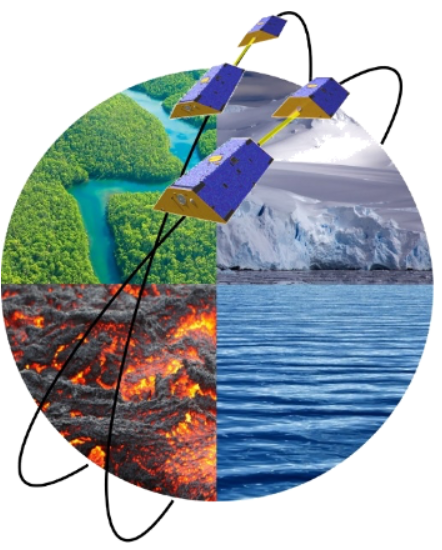
Overview
The Mass-Change and Geosciences International Constellation (MAGIC) is a planned National Aeronautics and Space Administration (NASA) and European Space Agency (ESA) joint venture that will include four Earth observation satellites (2 pairs), with each agency initially providing two. MAGIC will measure fluctuations in Earth’s gravitational field, allowing the study of hydrological phenomena such as mass transport, as well as building on the success of previous missions in the field, such as the Gravity Recovery and Climate Experiment (GRACE), and its follow-on mission, GRACE-FO. MAGIC will provide data continuity for the mass transport time series from these missions, as well as improvements in the temporal and spatial resolution of gravitational field mapping. This greater resolution in mapping Earth’s gravitational field will also allow enhanced study of mass transport, the shift of water mass between phases of the global water cycle, as mass transport has a calculable impact on gravitational field fluctuations. MAGIC satellites will operate in pairs, using changes in relative position to calculate gravitational field strength across the orbit. 1) 2) 3) 4) 5) 9)
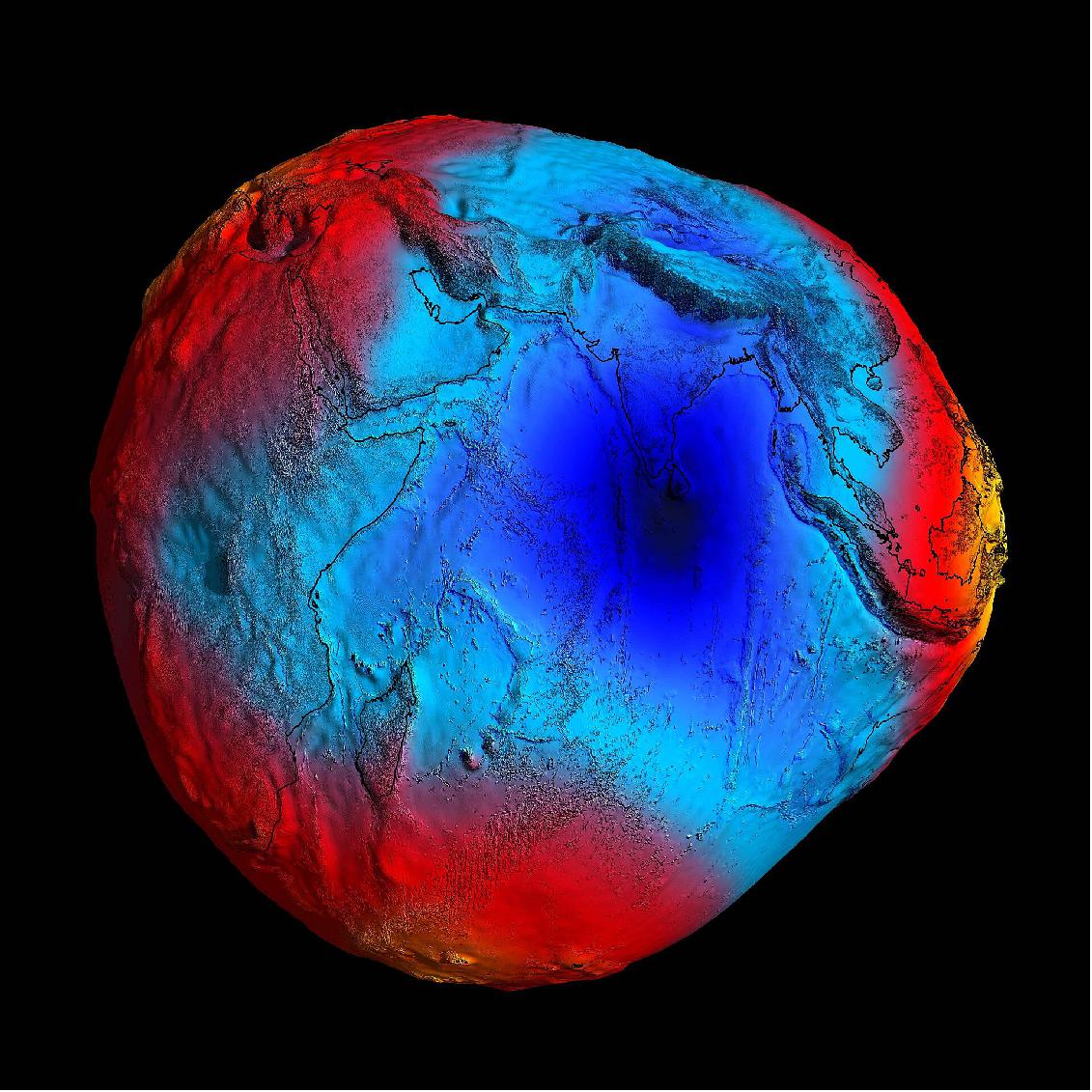
MAGIC will build upon ESA's successful history of gravity measurement from space, in the Gravity field and steady-state Ocean Circulation Explorer (GOCE) mission, which produced the most accurate model of Earth’s geoid to date, seen in Figure 1, as well as the joint US-German GRACE and GRACE-FO missions, which measured variations in gravity over time, revealing large scale mass transport. The MAGIC mission will operate in pairs in low Earth orbit (LEO), to maximise gravitational field strength, and will consist of two pairs, one in near-polar orbit (89° - 90°) and a second with an orbit inclination around 70°.
Spacecraft
The satellite pair under NASA development (P1) is called GRACE-C and will be heavily based on the heritage of the GRACE-FO satellites, the pair under ESA development (P2) is called Next Generation Gravity Mission (NGGM).
Each satellite is planned to have a seven year lifetime, after a maximum six-month commissioning period. NGGM pair is expected to have a common operation with GRACE-C for at least 3 years.
NGGM System design status and Phase A studies
The NGGM has completed the Phase A “extension” phase (8 months) after having successfully completed the Delta - Preliminary Requirement Review of the satellite design proposed by two consortia in competition (A and B, shown in figure 2) and is starting the phase B1 with an intermediate SRR planned in July 2025.
Each satellite will carry up to three ultra-fine accelerometers (for redundancy and enhanced on board calibration capability) and a Laser Tracking Instrument (LTI), i.e. a Michelson interferometer in transponder configuration.
The proposed designs rely on a Xenon mono-propellant solution to enable drag-compensation, formation and attitude control system (i.e. DFAOCS), allowing the satellites to be three-axis stabilized and nadir pointing, to track each other, and to implement drag compensation to minimise the disturbances on the accelerometer instruments.
The actuators devoted to lateral/cross-track drag compensation and attitude control are proportional cold gas thrusters, and those devoted to drag compensation are based on electric propulsion, aiming to cover a lifetime up to 7.5 years.
Several baseline and back-up thruster options have been presented and assessed.

The design of the spacecraft and dispenser were supported by detailed Finite Element Analyses. This allowed their verification for stiffness and strength, as well as the derivation of the dynamic environment of the payload units and the propulsion sub-system. The internal accommodation was verified by performing thermal analyses of the orbital environment, involving detailed Thermal Mathematical Models. These thermal analyses not only serve as reference for assessing the compatibility with the thermal specifications of the different units, but also provide the thermal maps employed by Thermo-Elastic Distortions preliminary analyses, based on accurate Finite Element Models. 13) 14)
NGGM Mission Concept
NGGM consists of two identical spacecraft (the concept design is shown in figure 2), embarking each a MicroSTAR accelerometer and the LTI, flying in an in-line formation.
The P2 pair will be launched on a VEGA-C rocket into a quasi-circular orbit (397 km altitude, 70 degrees inclination) - this design also compatible to polar/quasi-polar orbit.
Orbit altitude is maintained and ground track is controlled in a box of +- 1 km wrt.
Each satellite is enabled by hybrid propulsion (proportional cold gas plus electric propulsion), using the same propellant. Electric propulsion technologies are required to enable active drag compensation (1 dof or 3 dof).
The nominal intersatellite distance is 220 km and the nominal lifetime of each spacecraft is five years (after commissioning), designed and sized to embark consumable for a mission extension of at least two years.
Mission Status
- November 2020: ESA’s ministerial council decided to investigate a Next-Generation Gravity Mission (NGGM) in Phase A as a First Mission of Opportunity of the FutureEO program. 2)
- October 1, 2021: ESA’s Next Generation Gravity Mission (NGGM) is a candidate Mission of Opportunity for ESA–NASA cooperation in the frame of the Mass Change and Geosciences International Constellation (MAGIC). The mission aims at enabling long-term monitoring of the temporal variations of Earth’s gravity field at relatively high temporal (down to 3 days) and increased spatial resolutions (up to 100 km) at longer time intervals. 9)
- October 13, 2022: ESA and NASA announced that their joint ‘Next Generation Gravity Mission’, is undergoing its initial phase design activities, within the Mass Change and Geoscience International Constellation.
- November 23, 2022: The ESA Council at Ministerial level decided on an additional €2.7 billion to ESA’s Earth observation programme, and approved the commencement of the next ESA Earth Explorer, Harmony, and the MAGIC mission.
- March 2023: GRAC-C KDP-A has been reported as successfully passed on 16.03.
- April 25, 2023: ESA announced that NGGM Phase A is running an extension phase (8 months) up to the Delta Preliminary Requirement Review of the satellite design (July-September 2023), proposed by two consortia in competition.
- June, 2023: ESA approved the start of the procurement of Next-Generation Gravity Mission (NGGM) in Phase B1 based on an Instrument first approach. The procurement of the Microstar accelerometer and the Laser Tracking Instrument EM and EQM development were initiated together with the Phase B1 system studies.
MAGIC Instruments
Laser Ranging Instrument
The MAGIC sensor complement will carry similar instruments to the GRACE and GRACE-FO missions, with the key instrument being a Microwave Instrument (MWI), which enables K-band ranging, and a Laser Ranging Instrument (LRI) as a techno demonstrator embarked on GRACE-FO. GRACE-C will only embark Laser Ranging Instrument (LRI) as sole satellite inerdistance Instrument.
This NGGM LTI instrument based on LRI will allow ultra-precise satellite to satellite tracking (SST) and will be the main instrument on the NGGM (P2) satellites. From this ranging data corrected by accelerometers measurements, in orbit variations can be determined, allowing the derivation of the variable gravitational field strength across the orbit. MAGIC will utilise two satellite pairs, P1 and P2, providing greater and spatial temporal resolution: NGGM (P2) will weight more than 80% on the combined gravity retrieval, and to do P2 will fly in a low altitude orbit that is preferable for gravity missions, where the gravitational field strength is highest. The orbital configuration is shown in Figure 2, which depicts the ascending tracks of a circular orbit. 7)
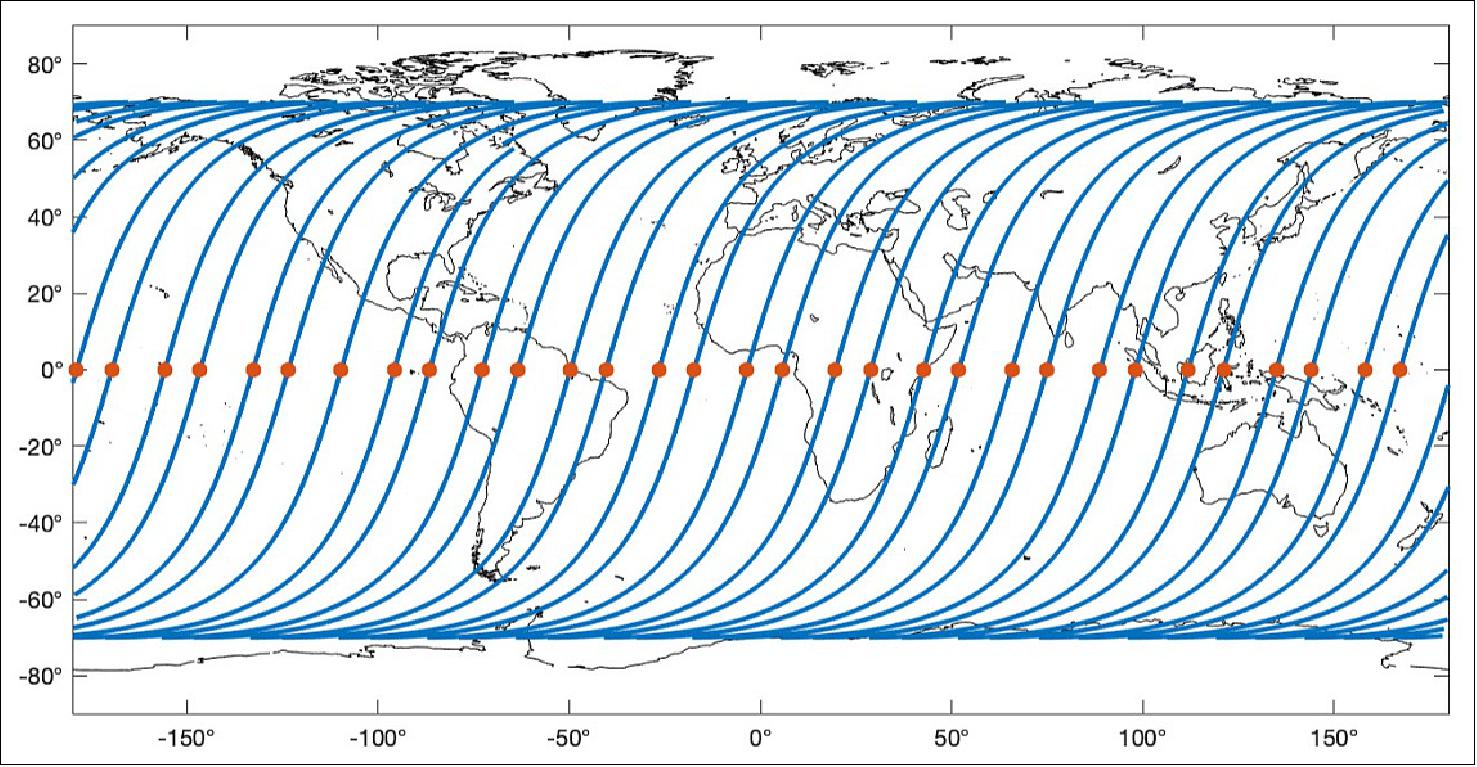
From this higher temporal resolution dataset, a greater understanding of mass transport processes within the Earth can be gained. Mass transport refers to the process of soil, regolith or rock being moved by ice or water. As such, detection of mass transport processes allows a greater understanding of the distribution of ice and water across the Earth, insights that are vital to future climate predictions and the understanding and prediction of global hydrological cycles. As mass transport shifts enormous amounts of the Earth’s crust, it can be detected in variations in Earth’s gravitational field, meaning the proposed MAGIC system will play a vital part in a future understanding of Earth’s hydrological processes.6) 8)
Accelerometers
GRACE-C pair will embark the same accelerometer than GRACE-FO, i.e. the Superstar from ONERA. The NGGM pair will embark the new generation Microstar accelerometer from ONERA.
The MicroSTAR accelerometer (as part of the payload suite in Figure 4) is composed of three units:
The accelerometer Sensor Head (ASH), with the mechanical parts of the sensor, as the proof-mass, ULE plates and and the electrode cage surrounding it.
The Front-End Electronic Unit (FEEU), which allows ultra-precise control of the proof-mass and to provides the acceleration measurement. Digital FEEU is baselined for NGGM.
The Interface and Control Unit (ICU), with the software for controlling the FEEU/ASH and for interfacing with the spacecraft, including the power conversion functionalities.
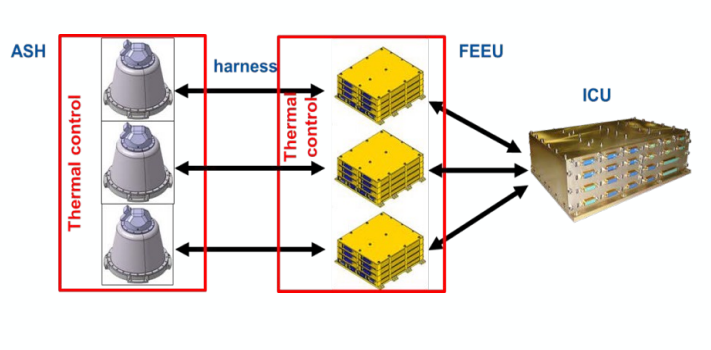
Performance Requirements
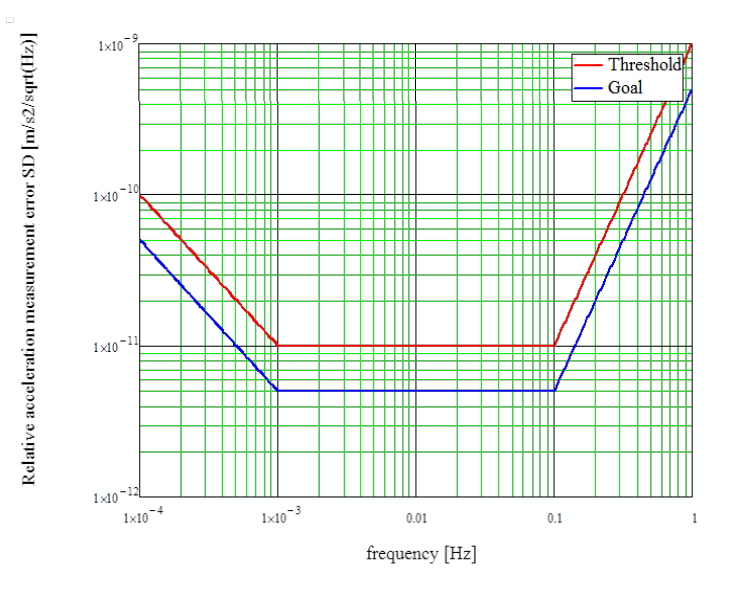
The MicroSTAR accelerometer has been designed to meet the top-level relative non-gravitational acceleration measurement error requirement along 3 ultra sensitive axis (figure 5).
NGGM Technology Pre-Development Activity on MicroSTAR Accelerometer
The activity focuses on the design of the ONERA’s MicroSTAR accelerometer, to fulfil the NGGM’s needs and specifications.
Its main objectives are to consolidate and propose a detailed accelerometer design, based on the GOCE GRADIO heritage capable of meeting the NGGM system requirements. The objectives are to procure, manufacture and test, in a representative environment, the units comprising the accelerometer suite for NGGM.
MicroSTAR accelerometer: Sensor Improvement
The objective is to obtain low-frequency noise of the accelerometer (around and below 1 mHz), and improve it, where possible, to the GOCE GRADIO accelerometer.
The performance shall be identical along the three directions (three ultra-sensitive axis), but limited in the axis where the thin discharge wire is located: thus, the design is based on a cubic proof mass. The accelerometer will support three linear plus three angular drag compensation DFAOCS control system.
Combination of proof mass translational and rotational measurements, is used for satellite attitude control.
MicroSTAR accelerometer: Performance improvement
Several parameters can be adjusted, to improve the accelerometer performance.
This includes Increasing the gap between proof-mass and electrodes, changing the material and the stiffness property of the proof-mass grounding wire (for discharging purposes), read-out electronics re-design, for decoupling the measured translational and rotational motion of the proof-mass.
The performance along the three axes can even be pushed closer to the 10-13 m/s1/2/Hz-1/2 noise floor, with heavier and cubic proof-mass.
Laser Tracking Instrument LTI
The LTI consists of an Instrument Control Unit (ICU) that includes a phasemeter, also called Laser Ranging Processor (LRP) in GRACE-C, a Laser Head Unit consisting of a narrow linewidth NPRO laser at 1064 nm wavelength with control electronics (LHU), and a Laser Stabilization Unit (LSU), made of a very stable optical cavity (CAV) and associated coupling optics (optical arm), to stabilize the laser in frequency.
Other units of the instrument are an interferometer Optical Bench Assembly (OBA), to host the interferometer optics, with the associated Optical Bench Electronics (OBE), a Retro-Reflector Unit (RRU), to route the beam to the other spacecraft, a scale factor measurements system (SFMS) for the measurement of the absolute laser frequency (called scale factor unit (SFU). For the full European concept the SFU will be part of the ICU.
Finally, also included is an Ultra Stable Oscillator (USO) for precise time tagging, currently traded off against the UCXO.
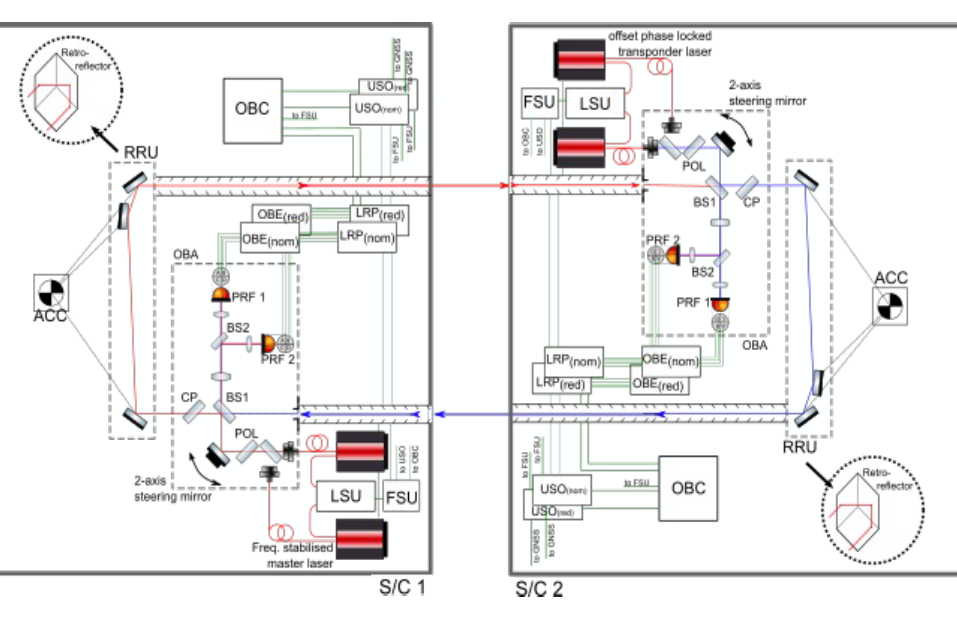
Performance Requirements
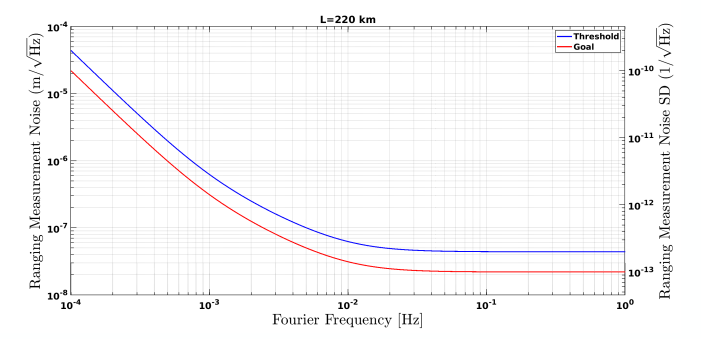
Figure 7 above shows the amplitude spectral density, as goal and threshold requirements of the inter-satellite distance variation (as reference, the performance @ 220 km inter-satellite distance is given on the left vertical axis).
The LTI has been designed to meet the top-level ranging measurement noise requirement above. The design is based on a trade-off between several former ESA development activities and the LaserRanging Interferometer (LRI), the US-German technology demonstrator embarked on GRACE-FO.
Propulsion Subsystem
The selection and definition of the NGGM propulsion technologies and system architectures, build on the heritage and lessons learned from the highly successful GOCE, and LISA Pathfinder missions.
The propulsion system requirements fall into two categories, which are the spacecraft attitude and orbit control (yaw, pitch and roll control, correction of disturbance forces along the cross-track and radial axis to the orbital plane), and atmospheric drag compensation (compensation of atmospheric drag force tangential to the orbital plane (along the velocity vector)).
Propulsion System Requirements
The requirements are ultra-fine throttable thrusters, with 1µN thrust knowledge control resolution, and very low thrust noise.
| Thrust Noise | PSD Frequency bandwidth |
|---|---|
| ≤ 30 μN/√Hz | < 3 mHz |
| ≤ 1 μN/√Hz | 30 mHz ≤ f < 10 Hz |
More requirements include wide throttling ranges of 1,000:1 for attitude, and 50:1 for drag compensation, and rapid throttling capability (>100µN. S-1) to compensate for localized atmospheric density variations, and swirling at higher frequencies.
Also, long lifetime (>70 khrs) and resilience to residual atmospheric constituents, e.g. ATOX, high specific impulse for ADC requirements (of the order of 2500s), and total impulse capability (of the order of 100kNs) for the relatively large drag compensation requirements, are needed.
Options and Design Status
For the relatively high thrust and total impulse requirements of drag compensation, efforts are focusing on the design of miniaturized electric propulsion (EP) thruster technology, specifically the miniaturised gridded ion thruster technology developed in Europe.
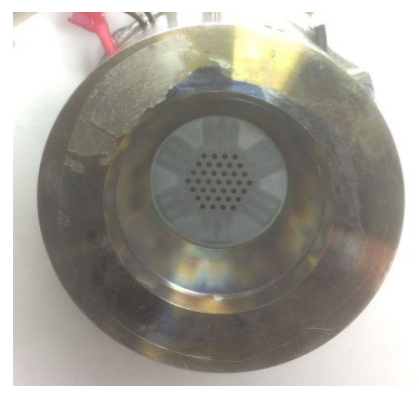
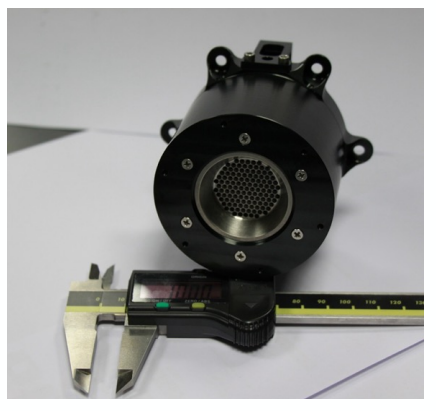
The neutralizer technologies under consideration for NGGM range from propellent-less (often referred as ‘dry’ thermionic electron emitters, to conventional hollow cathodes and RF neutralizer technologies. The latter two technologies also employ a flow of propellant and therefore impact the overall specific impulse of the system, although they are of a higher technology readiness level (TRL) .
The hollow cathode technology was successfully flown on the GOCE mission and is currently being developed for NGGM. Two examples of development neutralizers, immediately prior to diode emission, are presented below.
These devices have been manufactured and have a diameter of 32mm x 66 mm long and a mass of <350 g, including a thermal isolating mounting bracket. The devices have an inherently high emission current capability and hence provide a large growth capability for subsequent constellations that could employ multiple thrusters operating simultaneously.

For the relatively low thrust and low total impulse requirements of spacecraft attitude control, efforts are focusing on the application of more traditional, proportional cold gas thruster technology, such as the system flown on the LISA Pathfinder mission.
The relatively low Isp capability of this technology being offset by the lower total impulse requirements, power consumption and system complexity. 12)
Ground Segment
The MAGIC mission will deliver at least Level-1 and Level-2 data products to the science community. Its Level-1 products will be Low-Low satellite to satellite tracking (LL-SST) ranging for each pair, non-gravitational accelerations for each satellite, kinematic positions and velocities, attitude information, as well as other ancillary data such as temperature, satellite geometry model, surface characteristics, thrust, control and alignment information. The mission will also deliver two Level-1b products, de-aliasing products and tidal corrections. The Level-2 products of the MAGIC mission will be gravity field measurements, Level-2 de-aliasing products and precise science orbits. As well as these, Level-3 products, mass transport estimates for different areas and scales, will be selected. Most of the product processing processes are already well established due to the similarity in mission concepts between the MAGIC mission and the existing GRACE and GRACE-FO programs.
References
1) Daras, Ilias. “ESA/NASA Mass change And Geosciences International Constellation (MAGIC) mission concept – science and application prospects.” Meeting Organizer, URL: https://meetingorganizer.copernicus.org/EGU23/EGU23-13535.html
2) ESA Earth and Mission Science Division. “Next generation gravity mission as a mass change and geosciences international constellation (MAGIC) a joint ESA/NASA double-pair mission based on NASA's MCDO and ESA's NGGM studies- Mission Requirements Document.” 30 October 2020, URL: https://esamultimedia.esa.int/docs/EarthObservation/MAGIC_NGGM_MCDO_MRD_v1_0-signed2.pdf
3) “ESA - It's a kind of MAGIC.” European Space Agency, 24 May 2022, URL: https://www.esa.int/Applications/Observing_the_Earth/FutureEO/It_s_a_kind_of_MAGIC
4) Haagmans, Roger, et al. “Next Generation Gravity Mission as a Masschange And Geosciences International Constellation (MAGIC)- Mission Requirements Document.” MAGIC MRD, 30 October 2020, URL: https://www.asi.it/wp-content/uploads/2021/03/MAGIC_NGGM_MCDO_MRD_v1_0-signed2.pdf
5) “Mass Change (MC) | Science Mission Directorate.” NASA Science, URL: https://science.nasa.gov/earth-science/decadal-mc
6) “Ministers back ESA's bold ambitions for space with record 17% rise.” European Space Agency, 23 November 2022, URL: https://www.esa.int/About_Us/Corporate_news/Ministers_back_ESA_s_bold_ambitions_for_space_with_record_17_rise
7) Massotti et al, “Next Generation Gravity Mission Elements of the Mass Change and Geoscience International Constellation: From Orbit Selection to Instrument and Mission Design.” MDPI, URL: https://www.mdpi.com/2072-4292/13/19/3935
8) “SC 2.6: Gravity Inversion and Mass Transport in the Earth System - IAG.” Gravity Field, 2 October 2020, URL: https://com2.iag-aig.org/sub-commission-26
9) Technische Universität München, et al. “Simulation studies for a Mass change And Geosciences International Constellation (MAGIC).” TUM, URL: https://www.asg.ed.tum.de/fileadmin/w00cip/iapg/MAGIC/MAGIC_ExecutiveSummary.pdf
10) Wiehl, M., and M. Scheinert. “Mass Transport and Mass Distribution in the Earth System.” GFZpublic, URL: https://gfzpublic.gfz-potsdam.de/rest/items/item_231104_1/component/file_231103/content
11) Wiese, David. “Explore Earth- Mass Change Town Hall.” NASA Science, 13 December 2022, URL: [web source no longer available]
12) Massotti Luca, Bulit Alexandra, Daras Ilias, Carnicero Domínguez ernardo, Carraz Olivier, Hall Kevin, Hélière Arnaud, March Günther, Marchese Valentina, Martimort Philippe, Palmer Kyle, Rodrigues Gonçalo, Silvestrin Pierluigi, and Neil Wallace, “Next Generation Gravity Mission design activities within the MAGIC -Mass Change and Geoscience International Constellation”, ESA, EGU23, 14882, Vienna (virtual presentation), 25/04/2023, URL: https://presentations.copernicus.org/EGU23/EGU23-14482_presentation.pdf
13) Massotti, L., Bulit, A., Daras, I., Carnicero Dominguez, B., Carraz, O., Hall, K., Heliere, A., March, G., Marchese, V., Martimort, P., Palmer, K., Rodrigues, G., Silvestrin, P., and Wallace, N.: Next Generation Gravity Mission design activities within the MAGIC - MAss Change and Geoscience International - Constellation, EGU General Assembly 2023, Vienna, Austria, 24–28 Apr 2023, EGU23-14482, URL: https://doi.org/10.5194/egusphere-egu23-14482
14) Massotti Luca, Caiazzo Antonio, Carnicero Dominguez Bernardo, “Next Generation Gravity Mission design activities within the Mass Change and Geoscience International Constellation”, October 13, 2022, Clean Space Industrial Days, ESA-ESTEC, URL: https://indico.esa.int/event/416/contributions/7507/attachments/4913/7529/Clean%20Space%20Industrial%20Days_NGGM%20w_video_v3.pdf